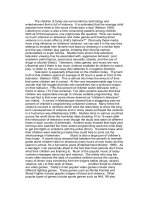blues music and its influence on integration
Bạn đang xem bản rút gọn của tài liệu. Xem và tải ngay bản đầy đủ của tài liệu tại đây (54.62 KB, 7 trang )
Blues Music And Its Influence On Integration
From years 1505 to 1870, the world underwent the largest forced
migration in history:
West Africa was soon to be convulsed by the arrival of Europeans and
become the advent of the transatlantic slave trade. Ships from Europe,
bound for America, appeared on the horizon, and their captains and
sailors-carrying muskets, swords, and shackles-landed on the coast,
walked up the beach in their strange clothes, looked around, and
demanded slaves. A horrific chapter in history had begun, and neither
Africa nor America would be the same again. (Awmiller 14)
Approximately ten million Africans were brought across the seas to the
Americas to be manipulated into slavery (14). It became apparent that
these African men, women and children were meant to generate money.
They were meant to work harsh labor, yet they were no longer meant to
have a voice. A few Americans took the time to appreciate the hard work
performed by the slaves; however, appreciation is a short step in the long
road to equality. It was not until the late 19th century that America began
to repair the damages done by this immoral trading of human beings.
Once the slaves were “freed” after the Emancipation Proclamation in
1863, it did not do much to end the oppression and prejudice against
their race. Their freedom did not give them a heart; it did not prove they
had soul. This is where their music becomes significant, and this is Blues
music (How the Blues Overview). Throughout their music, it took much
less time for the black race to prove that they were not unlike the rest of
humanity; in fact, they did have a voice, and a haunting one. Once Blues
music was not only recognized, but also comprehended, admired and
imitated, it opened the gates of immigration, and the nation to this day
has matured in its ability to see gray.
Included in the mass of faceless slaves, the boats entrapped and migrated
a large number of griots. A griot was an African version of the European
wandering minstrel. They spent their lives traveling from village to
village, playing the role of a musician, storyteller and wise man. They
typically carried an instrument similar to a guitar or banjo (Awmiller 13).
However, due to their rapid change in environment, they could no longer
sing the songs that they used to sing in their old villages; they invented
new songs. The griots invented new songs that addressed their new and
terrifying circumstances:
Songs about being chained on the ships below deck like animals, about
those who did not survive the brutal crossing to New World, and about
the homes they would never see again. And once in America, there were
other hardships to sing about: the ignominy of the auction block, the
separation of family members, the remorseless treatment at the hands of
landowners. (15)
Even though their masters, and most slave owners at the time, continued
a wave of new laws and restrictions to suppress the threatening culture of
Africa, these griots and these slaves used their new style of music to cry
out against these blatant wrongdoings to their race. They needed an
escape to retain the essentials of their culture, of their motherland of
which they undoubtedly could not suppress the memories of values and
of experiences known previously to them. By the end of the Civil War,
these slaves had blended African and European influences to recreate
their own culture. This neo-African culture included African-American
styles of dance and storytelling, work and spirituality, conversation and
community. “By sifting among the many elements of this vibrant,
life-sustaining world, we can trace the specific musical roots of what
would be known, by the end of the century, as ‘the blues’”(15).
Blues music originated in the cotton fields of the southern United States
where the majority of the slave hands were put to work. “The earliest
folk-blues were sung by nameless African-Americans living and working
in the South’s cotton belt in the early 1880’s and 1890’s- in particular,
the region from the Mississippi Delta to East Texas”(Barlow 3). It was
believed that this began as a call and response style, which matured into
the work song. From that standpoint, after the release of the slaves, the
work song then matured into their Spirituals, and later was introduced to
the whites through black-faced Minstrel of Medicine shows (How the
Blues Overview). As the music matured and became more renowned, its
influence became prominent in the music styles of the time, and in the
intertwining relationships between the races. “The music was a unique
and cultural offering that whites could not deny. It was something new
and intriguing to whites that shed a new light on blacks and their place in
American culture and society”(Overview). The music did not seem to
have the same color restrictions as the music previously performed. It
drew blacks and whites together in a place where everyone could leave
the Jim Crow laws at the door (Overview). This offered a new and
beneficial lifestyle for the blacks as well as the whites. Maybe the
interest was that the white people had found a new talent to exploit and
from which to make easy money, or perhaps, maybe it was because the
whites genuinely understood the cultural significance in the music and
respected this talent of the black race enough to overcome racial and
cultural differences.
“The white slave owners were intrigued by the slaves’…music…[and]
encouraged the slaves to sing and play…because they felt that the slaves
were happier-and less rebellious-if they were allowed to make their
music”(Haskins 9). While their music was obviously something these
slaves were using to keep their African heritage, the whites believed that
their music was an expression of happiness and contentment. They
believed that their singing was an expression of their acceptance of their
hard fate. Former slave Frederic Douglas wrote that the music of these
slaves reflected an expression of the opposite:
“I have often been utterly astonished, since I came to the North, to find
persons who could speak of the singing among slaves as evidence of
their commitment and happiness. Slaves sing most when they are most
unhappy. The songs of the slaves represent the sorrows of his life; and he
is relieved by them only as an aching heart is relieved by tears.”(Douglas
97)
“In the early 19th century, advertisements would point out the musical
talents of these slaves who were for sale knowing that would put them in
higher demand”(Davis 27-28). It was due to the whites’ misconception
that those slaves who displayed musical talent were typically given easier
work and rewards for their talent and their seeming obedience of their
labor. At times these slaves were bought specifically for their musical
talent and were never subjected to harsh fieldwork. Sometimes, these
black workers were invited to weekend parties, asked to perform, and
were given whiskey, food and other rewards for their services. “Blues
music was not only an essential element of many religious and secular
events for blacks, but it was a substantial source of entertainment for
whites as well” (How the Blues Appreciation). This displays historically
the establishment of the white man’s genuine appreciation for black
music.
In 1903 Mr. W.C. Handy, later referred to as the ‘Father of the Blues,’
hears his inspiration. He notices a ruggedly dressed old black man sitting
on a bench, playing guitar. Handy wrote the notes of the old man’s
down:
Rather than strumming and picking the strings, the man was sliding an
open pocketknife up and down the guitar’s neck making the notes bend
and slide, the strings moan and wail. The sound was so much like a
human voice that you could almost say the guitar was crying. (Awmiller
12)
Gertrude “Ma” Rainey, a professional vaudeville singer, told a similar
experience. She heard a young woman singing outside her vaudeville
tent, a strange and “poignant song,” about her man who left her. In
addition, further away, a white violin player named Hart Wand was
playing a melody that an African-American employee of his father’s said
gave him ‘the blues’ (12). So, what is it that exactly constitutes the
Blues? Cross rhythms were used extensively in the Blues. This was also
prominent within the old West African drumming. This was popularly
created by separating the melodic line from the groundbeat, which then
puts the two in rhythmic conflict, and was done by a solitary musician
singing or playing emphasizing the offbeat. Possibly the most prominent
innovation was their melodic tendency to express rising emotions with
falling pitch. This became such a trademark with the African expression
of Blues, that it is now referred to as playing "blue notes." Finally, Blues
musicians rarely used the same style of voice. Blues was a mixture of
coarse guttural tones and slurs to falsetto and melisma, and this was all
used to color the melodic line and give it identity and expressiveness;
which all of these trademarks they innovated from their old West African
music (Barlow 4). With this entire struggle from the white folks to
weaken the African's African heritage, it seems implausible to believe
that the slaves' music was what threw the first stone at the barriers
between the blacks and whites. It was the Minstrel and Medicine shows
from the 1830's that gave the whites their first opportunity to delve into
the culture of the slaves and their music- in the beginning with the
lingering alibi of show business. A minstrel show was a musical event
where white folks got the chance to paint their faces black with burnt
cork and perform in the persona of a black man. This gave the white
Americans their first taste of the black man's music in a harmless
environment free of the black man. Many white American's in blackface
and black attire were able to travel around the country, spreading the
musical style of the blacks they had heard before to others who may not
have had the opportunity. This may have aided in the increasing
popularity of a stereotyped black man, " however, if it is true that
imitation is the utmost form of flattery, then these shows were evidence
of white's attraction and fondness for black culture"(How the Blues
Minstrel and Medicine). “The first minstrel tune identified as such to
make a dent
in the national consciousness was Tim Rice's 'Jump Jim Crow,' published
in 1830 [first] sung by a black stable hand in Louisville,
Kentucky"(Davis 36). These medicine shows were “an entry into a world
in which black could be white, white could be black, anything could be
itself and simultaneously opposite"(37). There were many white men
who thought the show’s purpose was to make a joke at the black man's
expense; however, most of the white actors performing at these shows
sincerely wished to be able to portray the musical style, and obtain and
imitate the culture possessed by the black race. Although this
information of the black music and its culture was second hand, it
insinuated the presence of the black man, and foreshadowed the arrival
of black men and women musicians into the music business. Therefore,
it seems almost ironic again that while some of these white men were
trying to discriminate against the blacks with these shows, they were
unknowingly aiding in the blacks capability to later repossess the same
rights as the white men had. In fact, it was these black-face minstrel
shows that later gave the blacks the right to play in the same shows.
After Minstrel shows, the Medicine shows then became popular around
the turn of the century. They became the first shows to feature and
entertain both white and black Americans. This was possibly the most
influential in respect to race relations. These shows still offered the
whites a chance to put on a black face; however, both the blacks and
whites were finally agreeing on something-music. This is where country
and blues came together, and both grew to be a highly vital and
influential landmark in music history. These shows remained popular
after the Civil War and onward after the Reconstruction period, a time
span from 1860 until 1877(How the Blues Minstrel and Medicine).
These shows confirmed the common objective of both races and secured
the flourishing business between the two. While both black and white
musicians borrowed freely from each other's style of music, the black's
Blues music proved to be the most indispensable in style with its grainy
vocal texture and its distinctive emphasis on rhythmic momentum. “It
was this distinction that made black entertainers indispensable and
continued to cultivate white appreciation for black music"(Minstrel and
Medicine). This is now years after Lincoln's Emancipation Proclamation,
and it was around this time that some white citizens were beginning to
see their former slaves as important contributors to American culture.
“Whites began recording the blues in the early 20th century thus
extending the typical relationship between blacks and whites in a
positive direction”(White Interest). As both races began to work
together, they began to develop the same ideals and goals, and realizing
it or not, began to change history to better the future for humanity. The
black musicians had already been playing in the medicine shows and for
some time had begun to travel around and perform for the white folk
who appreciated their music. The white businessmen took notice of this
and, after a while, decided to market this private operation. The blues
music of the blacks was gaining popularity throughout the United States,
and white business saw this as an opportunity to make a profit. (Thank
heavens for capitalism!) Although this seems to possess a negative affect
on the black race and their music, it really helped develop their rights,
especially in the music business and their ability to grow as musicians.
The record companies sent out scouts to find these talented musicians
and record them. With the success of one blues artist, there came the
success of the rest. This flourished in the 1920's especially. With the
successes that these blues men were having, it was
decided that they probably did know a few things about music. These
record companies, owned by white men, were hiring these black Blues
musicians to be consultants on which albums to promote and the style in
which to promote it. Despite displaying a stereotypical black,
advertisements were selling their Blues albums. It was displaying to the
public that these black men and women did have talent and were being
viewed more as (nearly equal) human beings, and less and less as simple
workers. "Making music is a circumstance under which people of both
races could mix without raising very many eyebrows"(Integration of
Musicians). This later assisted to break open civil rights barriers due to
the slow change in the national consciousness of the time. “Rumor has it
that the local chapter of the Ku Klux Klan managed Jaybird Coleman, an
early Blues harmonica player"(Integration of Musicians). It was about
this time period, around the late1930’s, that Blues no longer was being
played strictly by black musicians, but was being imitated, accurately, by
white Blues musicians. Some white musicians imitated the black music
style of Blues so well that in some instances it is undecided today who
was white and who in fact was truly black upon listening to old
recordings. This proves that this imitation was done now strictly by
admiration, and no longer was being imitated by the whites simply as a
spoof as much as the Minstrel music was. In addition, not only were the
whites imitating the Blues music, but also the country music style of
white music was being integrated into the black style of Blues. This
proves that the culture between the blacks and whites was beginning to
mix and blur, and this was due to the affects of the intrigue of Blues
music.
Although it was socially acceptable for the Blues musicians to write,
compose and produce their music, it was frowned upon, until the late
1950's, that the teenage generation be exposed to black Blues musicians.
However, white Blues musicians were another story. The distribution of
Blues music was eased into the public by using white covers of black
artists (Covers and Dances). Ironically enough, the white covers of these
black artist’s music never climbed as high on the top-seller list as the
ones originally put out by the black musicians themselves. In 1956, white
musician Pat Boone did a cover of the black Blues artist Little Richard's
“Tutti Frutti" that reached number 18 on the bestseller chart. However,
when Little Richard put out his own release of "Long Tall Sally" later in
that same year, before Boone put out his cover of it, Little Richard
already had it at number six. This simply proves that, however
attempting to slow the eventual rise of black artists, they were in fact
hastening the inevitable. "Nothing did more than the cover phenomenon
to facilitate a mass market for r&b and extend the opportunities for black
artists…”(Ward 44). These covers simply expedited the process of the
mass exposure of the public, and this quickly developed a curious
fondness for Blues and its African culture. Eventually, it did not matter
who was singing, as long as it was performed well. This Blues
phenomenon created a neutral ground for both blacks and whites to share
and, henceforth, improve their relationship. Although the black slaves
had long been freed, notably there remained in the southern United States
an excessive number of restrictions on the black population. These were
the infamous “Jim Crow” laws. However, when the blacks and whites
got together at dances, these seemed to begin to falter and then
disappear. The dances would begin with the officials stringing a rope
dividing the dance floor in half to keep the races from mingling. "As the
evening wore on, the music was able to swallow up the Jim Crow laws
[and] it was always the whites who instigated the crossover because a
black man doing so risked being lynched"(How the Blues Covers &
Dances). Another beautiful display of this liberalism was when the radio
became integrated. About 80 members of the Ku Klux Klan were beating
down the doors of an Alabama radio station for playing the talent of
black Blues artist Shelley "Playboy" Stewart. Their aim that night was to
kill the owner sitting inside. The owner, Ray Mahoney, suggested that
the Ku Klux Klan did not think that "The Playboy" was good enough to
play for them. All 800+ of the white kids inside jumped out the doors of
the station and proceeded to assault the Klan, the same race as they, to
fight for one black man (Integrated Radio). Literally, they saved the poor
black man's life that night; symbolically, they helped save the entire
black race from such persecution. While this sort of activity seemed to
happen while the music was playing, and playing good, this remains
symbolic of the whites’ willingness to deconstruct the racism and
prejudice prominent of the time. After Elvis, the barriers between black
and white music were broken down entirely. The majority of white
teenagers, and those within other age brackets, began to see the
significance of the Blues in music and lifestyle, and all were worshipping
the music and its musicians-white and black. It was because of Blues
music that white kids ventured into black areas and had a sense of “fair
play” long before the civil rights movement (Blues and Rock). As there
will always be, there were those people who were disgusted with this sort
of music, behavior, belief, and lifestyle. However, historically and
recently, this is disregarded as “conservative fluff" and discarded in a
hurry. Once the Blues got this far, there was no mercy and no turning
back. It seemed as though Blues music did more for the civil rights
movement than Brown vs. the Topeka Board of Education (Blues and
Rock). Blues was similar to a small leak on a dam, and once the water
broke through, it was best to watch it run its course.
Traditional Blues music is reflected in modern music, which displays
vague or blatant Blues influences. However, the Napoleons of the Blues
shall never be forgotten because they fought a war America had at one
time decided it could never win. The music instilled faith into the hearts
of many black Americans and at the same time instilled empathy and
passion in the white Americans. It not only congregated people, it
congregated two separate cultures, both as different as black and white.








![thang nguyen ngoc - 2011 - corporate governance and its impact on the performance of firms in emerging countries - the evidence from vietnam [cg]](https://media.store123doc.com/images/document/2015_01/02/medium_rfd1420194809.jpg)
